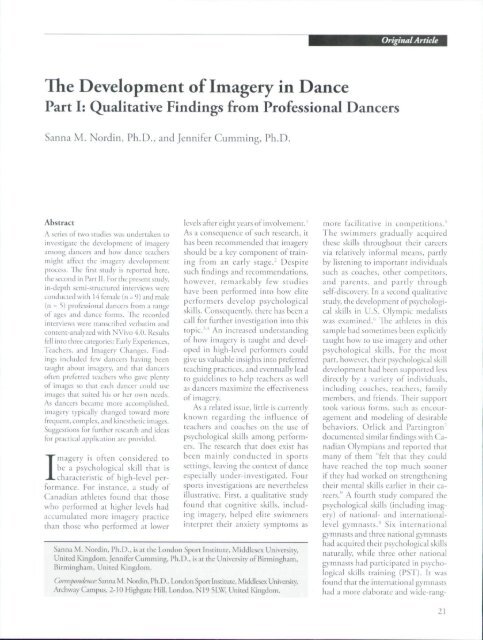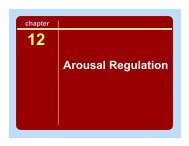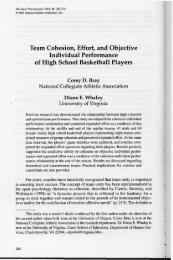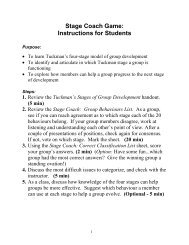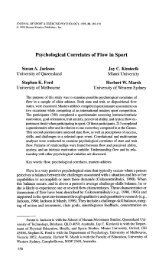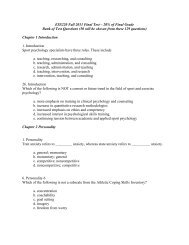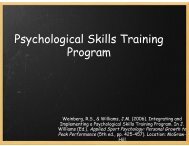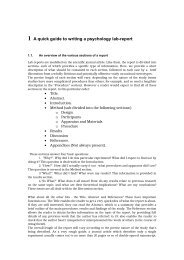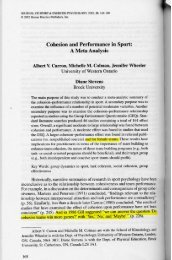The Development of Imagery in Dance
The Development of Imagery in Dance
The Development of Imagery in Dance
You also want an ePaper? Increase the reach of your titles
YUMPU automatically turns print PDFs into web optimized ePapers that Google loves.
Orig<strong>in</strong>al Article<br />
<strong>The</strong> <strong>Development</strong> <strong>of</strong> <strong>Imagery</strong> <strong>in</strong> <strong>Dance</strong><br />
Part I: Qualitative F<strong>in</strong>d<strong>in</strong>gs from Pr<strong>of</strong>essional <strong>Dance</strong>rs<br />
Sanna M. Nord<strong>in</strong>, Ph.D., and Jennifer Cumm<strong>in</strong>g, Ph.D.<br />
Abstract<br />
A series oi two .studies was undtTtaken ro<br />
<strong>in</strong>vfstif;atc the development <strong>of</strong> imagery<br />
among dancers and how dance teachers<br />
might attect the imagery development<br />
process. "Ihe Hrst study is reported here,<br />
the second <strong>in</strong> Part II. For the present study,<br />
<strong>in</strong>-depth semi-structured <strong>in</strong>terviews were<br />
conducted with 14 female (n -9) and m;iJe<br />
(n - 5) pr<strong>of</strong>essional dancers from a range<br />
<strong>of</strong> ages and dance forms. Ihe recorded<br />
<strong>in</strong>terviews were transcribed verhatim and<br />
content-analyzed with NVivo 4.0, Results<br />
fell <strong>in</strong>to three categories: Early Experiences,<br />
Teachers, and <strong>Imagery</strong> Changes. F<strong>in</strong>d<strong>in</strong>gs<br />
<strong>in</strong>cluded few dancers hav<strong>in</strong>g been<br />
taught about imagery, and that dancers<br />
<strong>of</strong>ten preferred teachers who gave plent\'<br />
o( images so that each dancer could use<br />
images that suited Ins or her own needs.<br />
As dancers became more accomplished,<br />
imagery typically changed toward more<br />
frequent, complex, and Idnesthetic images.<br />
Suggestions tor further research and ideas<br />
for practical application are provided.<br />
Iniiigtry is <strong>of</strong>ten considered to<br />
be ;i psycbological skill that is<br />
characteristic <strong>of</strong> high-level performance.<br />
For <strong>in</strong>stance, a study <strong>of</strong><br />
Canadian athletes found that those<br />
who performed at higher levels had<br />
accumulated more imagery practice<br />
than those who performed at lower<br />
levels after eight years <strong>of</strong> <strong>in</strong>volvement.'<br />
As a consequence <strong>of</strong> such research, it<br />
has been recommended that imagery<br />
should be a key component <strong>of</strong> tra<strong>in</strong><strong>in</strong>g<br />
from an early stage.' Despite<br />
such f<strong>in</strong>d<strong>in</strong>gs and recommendations,<br />
however, remarkably few studies<br />
have been performed <strong>in</strong>to how elite<br />
performers develop psychological<br />
skills. Consequently, there has been a<br />
call for further <strong>in</strong>vestigation <strong>in</strong>to this<br />
topic.'"^ An <strong>in</strong>creased understand<strong>in</strong>g<br />
<strong>of</strong> how imagery is taught and developed<br />
<strong>in</strong> high-level performers could<br />
give us valuable <strong>in</strong>sights <strong>in</strong>to preferred<br />
teach<strong>in</strong>g practices, and eventually lead<br />
to guidel<strong>in</strong>es to help teachers as well<br />
as dancers maximize the effectiveness<br />
<strong>of</strong> imagery.<br />
As a related issue, little is currently<br />
known regard<strong>in</strong>g the <strong>in</strong>fluence <strong>of</strong><br />
teachers and coaches on the use <strong>of</strong><br />
psychological skills among performers.<br />
Ihe research that does exist has<br />
been ma<strong>in</strong>ly conducted <strong>in</strong> sports<br />
sett<strong>in</strong>gs, leav<strong>in</strong>g the context <strong>of</strong> dance<br />
especially under-<strong>in</strong>vestigated. Four<br />
sports <strong>in</strong>vestigations are nevertheless<br />
illustrative. First, a qualitative study<br />
found that cognitive skills, <strong>in</strong>clud<strong>in</strong>g<br />
imagery, helped elite swimmers<br />
<strong>in</strong>terpret their anxiety symptoms as<br />
Sanna M. Nord<strong>in</strong>, Ph.D., is at the l.ondon Sport Insiitute, Middlesex University,<br />
United K<strong>in</strong>gdom. Jennifer Cumm<strong>in</strong>g, Ph.D., isat the University <strong>of</strong> Birm<strong>in</strong>gham,<br />
Birm<strong>in</strong>gham, United K<strong>in</strong>gdom.<br />
Correspondence: Sanna M. Nord<strong>in</strong>, Ph.D., London Sport Institute, Middlesex University,<br />
Archway Campus, 2-10 Highgate Hill, london, N19 5LW, United K<strong>in</strong>gdom.<br />
more facilitative <strong>in</strong> competitions.^<br />
<strong>The</strong> swimmers gradually acquired<br />
these skills throughout their careers<br />
via relatively <strong>in</strong>formal means, partly<br />
by listen<strong>in</strong>g to important <strong>in</strong>dividuals<br />
such as coaches, other competitors,<br />
and parents, and partly through<br />
self-discovery. In a second qualitative<br />
study, the development <strong>of</strong> psychological<br />
skills <strong>in</strong> U.S. Olympic medalists<br />
was exam<strong>in</strong>ed.'' Tlie athletes <strong>in</strong> this<br />
sample had sometimes been explicitly<br />
taught how to use imagery and other<br />
psychological skills. For the most<br />
part, however, their psychological skill<br />
development had been supported less<br />
directly by a variety <strong>of</strong> <strong>in</strong>dividuals,<br />
<strong>in</strong>clud<strong>in</strong>g coaches, teachers, family<br />
members, and friends. <strong>The</strong>ir support<br />
took various forms, such as encouragement<br />
and model<strong>in</strong>g <strong>of</strong> desirable<br />
behaviors. Orlick and Part<strong>in</strong>gton^<br />
documented similar f<strong>in</strong>d<strong>in</strong>gs with Canadian<br />
Olympians and reported that<br />
many <strong>of</strong> them "felt that tbey could<br />
have reached the top much sooner<br />
if they had worked on strengthen<strong>in</strong>g<br />
their mental skills earlier <strong>in</strong> their careers."<br />
A fourth study compared the<br />
psychological skills (<strong>in</strong>clud<strong>in</strong>g imagery)<br />
<strong>of</strong> national- and <strong>in</strong>ternationallevel<br />
gymnasts.*^ Six <strong>in</strong>ternational<br />
g\'mnasts and three national gymnasts<br />
had acquired their psychological skills<br />
naturally, while three other national<br />
gymnasts had participated <strong>in</strong> psychological<br />
skills tra<strong>in</strong><strong>in</strong>g (PS'F). It was<br />
found that the <strong>in</strong>ternational gymnasts<br />
had a more elaborate and wide-rang-<br />
21
22 Volume 10, NiimhcTs I 6" 2, 2006 • Journal <strong>of</strong> <strong>Dance</strong> Medic<strong>in</strong>e C^ Science<br />
<strong>in</strong>g repertoire <strong>of</strong> psychological skills<br />
than their national counterparts.<br />
However, the PST program helped<br />
the three national g)'mnasts acquire<br />
skills similar to those employed by the<br />
<strong>in</strong>ternational gymnasts. As a result,<br />
the quality and complexity <strong>of</strong> their<br />
imagery and other skills stu'passed<br />
those <strong>of</strong> the three national-level gymnasts<br />
who had nor received any formal<br />
tra<strong>in</strong><strong>in</strong>g.<br />
Research conducted thus far <strong>in</strong><br />
sptirts seetiis to suggest that the acquisition<br />
<strong>of</strong> imagery skills by athletes<br />
usually occurs gradually, via different<br />
sources, and <strong>of</strong>ten <strong>in</strong>direct methods.<br />
Structured imagery tra<strong>in</strong><strong>in</strong>g programs<br />
can improve this process*^ " but are<br />
not the usual means by which athletes<br />
learn about imagery. By comparison,<br />
available sttidies suggest that dancers<br />
may learn about imagery <strong>in</strong> a slightly<br />
more direct manner. For <strong>in</strong>stance, a<br />
comparison ot the imagery <strong>in</strong>structional<br />
methods used by three groups<br />
<strong>of</strong> <strong>in</strong>structors found that dance<br />
teachers and figure skat<strong>in</strong>g coaches<br />
encouraged their performers to use<br />
imagery more than did soccer coaches<br />
before and dur<strong>in</strong>g practices, as well as<br />
before performances.''<strong>The</strong> similarities<br />
between the dance <strong>in</strong>structors and figure<br />
skat<strong>in</strong>g coaches are not altogether<br />
surpris<strong>in</strong>g given the artistic nature<br />
that is <strong>in</strong>herent to both activities. It<br />
should be noted that when Overby<br />
and colleagues described encouragement<br />
to use imagery, they were<br />
referr<strong>in</strong>g to concrete types <strong>of</strong> images,<br />
such as rehears<strong>in</strong>g skills and sequences<br />
<strong>in</strong> one's head.'' However, they also<br />
<strong>in</strong>vestigated the <strong>in</strong>structors' use <strong>of</strong><br />
metaphorical images. Tliese are more<br />
abstract, <strong>of</strong>ten referr<strong>in</strong>g to actions<br />
and sensations that may not be objectively<br />
possible, for example "mov<strong>in</strong>g<br />
across the floor as if mov<strong>in</strong>g through<br />
water,"'- or "walk<strong>in</strong>g and turn<strong>in</strong>g as<br />
if there were no gravity to keep yoti<br />
earthbound."'' It has previously been<br />
found that dance teachers frequently<br />
give out such metaphorical images<br />
<strong>in</strong> classes as <strong>in</strong>structional cues or as<br />
<strong>in</strong>spiration for their sttidents." To<br />
return to the direct comparison study<br />
done by Overby and colleagties, It was<br />
found that dance teachers used more<br />
metaphorical imagery than either<br />
figure skat<strong>in</strong>g or soccer coaches.''This<br />
is an <strong>in</strong>terest<strong>in</strong>g f<strong>in</strong>d<strong>in</strong>g because such<br />
images have been shown to improve<br />
performance, both for children and<br />
for student dancers.'* "' Yet, apart<br />
from the work done by Overby and<br />
colleagues, all <strong>of</strong> the aforementioned<br />
studies concern<strong>in</strong>g imagery development<br />
have focused solely on concrete<br />
types <strong>of</strong> imagery, to the exclusion <strong>of</strong><br />
metaphorical imagery types."'"''^<br />
A third and f<strong>in</strong>al po<strong>in</strong>t to note from<br />
the restilts <strong>of</strong> Overby and colleagues<br />
was that none <strong>of</strong> the three groups <strong>of</strong><br />
<strong>in</strong>strtictors (dance teachers, figure<br />
skat<strong>in</strong>g coaches, or soccer coaches) reported<br />
us<strong>in</strong>g imagery <strong>in</strong> an organized<br />
way.'- lliis is noteworthy because it<br />
has been suggested that imagery use<br />
shotild be structured and regular for<br />
best effect.' Gould, Damarjian, and<br />
Medbery reported similarly unsystematic<br />
<strong>in</strong>corporation <strong>of</strong> mental skills <strong>in</strong>to<br />
junior tennis coach<strong>in</strong>g, despite more<br />
than half <strong>of</strong> their sample consist<strong>in</strong>g <strong>of</strong><br />
coaches with some sports psychology<br />
tra<strong>in</strong><strong>in</strong>g.'" More encourag<strong>in</strong>gly. Hall<br />
and Rodgers found that follow<strong>in</strong>g a<br />
mental skills tra<strong>in</strong><strong>in</strong>g program with<br />
figure skat<strong>in</strong>g coaches, the athletes<br />
coached by the participants reported<br />
that their lessons had improved.''<br />
Given these f<strong>in</strong>d<strong>in</strong>gs and the<br />
general lack <strong>of</strong> research <strong>in</strong>to imagery<br />
development, two studies were undertaken.<br />
'Ihc broad aims <strong>of</strong> these studies<br />
were to enhance our understand<strong>in</strong>g<br />
<strong>of</strong> how imagery develops <strong>in</strong> dancers,<br />
and to <strong>in</strong>vestigate the role <strong>of</strong> the dance<br />
teacher for a dancer's imagery development.<br />
Because the area is relatively<br />
under-<strong>in</strong>vestigated, qualitative methods<br />
were deemed suitable as a first step<br />
to explore imagery development <strong>in</strong><br />
depth. Elite performers were chosen<br />
to participate <strong>in</strong> Part I because they<br />
are likely to have superior experience<br />
and knowledge <strong>of</strong> imagery compared<br />
to lower-level performers."^" As part<br />
<strong>of</strong> a larger qualitative study perta<strong>in</strong><strong>in</strong>g<br />
to dance imagery, we employed a<br />
sample <strong>of</strong> 14 pr<strong>of</strong>essional dancers. "Ihe<br />
<strong>in</strong>terview results perta<strong>in</strong><strong>in</strong>g to imagery<br />
development are thus reported <strong>in</strong> the<br />
present paper (Part I). To complement<br />
these f<strong>in</strong>d<strong>in</strong>gs with more generalized<br />
data, a second study was conducted.<br />
That study built on the f<strong>in</strong>d<strong>in</strong>gs <strong>of</strong><br />
Part 1 by us<strong>in</strong>g a quantitative methodology<br />
to <strong>in</strong>vestigate imagery development<br />
with a large, heterogeneous<br />
sample, and the results <strong>of</strong> that study<br />
arc presented <strong>in</strong> a separate paper (Part<br />
H).<br />
In sum, the aims <strong>of</strong> the present<br />
<strong>in</strong>vestigation were to ga<strong>in</strong> an understand<strong>in</strong>g<br />
<strong>of</strong> how imagery develops <strong>in</strong><br />
dance sett<strong>in</strong>gs, and to explore the role<br />
<strong>of</strong> dance teachers <strong>in</strong> imagery development.<br />
In the study presented here,<br />
semi-structured qualitative <strong>in</strong>terviews<br />
were conducted to get a first, exploratory<br />
<strong>in</strong>sight <strong>in</strong>to the topic.<br />
Method<br />
Participants<br />
Fourteen pr<strong>of</strong>essiotial dancers were<br />
recruited to participate <strong>in</strong> this study.<br />
N<strong>in</strong>e were female and five were male,<br />
and their ages ranged from 22 to 42<br />
(M - 30.00, SD - 6.71). Six dancers<br />
worked <strong>in</strong> classical ballet, one <strong>in</strong><br />
Kathak, and six <strong>in</strong> various types <strong>of</strong><br />
contemporary dance. One participant<br />
no longer described herself as a<br />
dancer but as someone who <strong>in</strong>tegrates<br />
live art, performance and video with<br />
contemporary dance <strong>in</strong> her work. 'Ihe<br />
sample had participated <strong>in</strong> dance for<br />
21.85 years (SD - 5.64) and they had<br />
been pr<strong>of</strong>essionals for 7.61 years (SD<br />
= 4.63). <strong>The</strong>y first took up dance at<br />
7.64 years <strong>of</strong> age (SD - 5.47).<br />
Materials<br />
Questions concern<strong>in</strong>g imagery development<br />
were constructed for an <strong>in</strong>terview<br />
guide based on the exist<strong>in</strong>g relevant<br />
literature <strong>in</strong> dance and sports psychology.'*'''""<br />
Ihese questions concerned<br />
the reasons why the dancers first began<br />
us<strong>in</strong>g imagery, whether they started to<br />
do so nattirally or were explicitly taught,<br />
and how their imagery skills had developed<br />
across their careers. <strong>The</strong> role <strong>of</strong> the<br />
teacher, both when the dancers were<br />
younger and at the present time, was<br />
also explored. Ihese questions concerned<br />
whether teachers gave out images <strong>in</strong><br />
class, and whether teachers encouraged<br />
the dancers to image on their own. Ilie<br />
use <strong>of</strong> an <strong>in</strong>terview guide ensured that<br />
the same open-ended ma<strong>in</strong> questions
Journal <strong>of</strong> <strong>Dance</strong> Medic<strong>in</strong>e t:f Science • Volume 10, Numbers 1 cf 2, 2006 23<br />
were asked from all participants, while<br />
allow<strong>in</strong>g the <strong>in</strong>terviewer to use elaboration-<br />
and clariHauion-probes as deemed<br />
necessary.'*' Ihe <strong>in</strong>terview guide can be<br />
obta<strong>in</strong>ed from the authors on request.<br />
Procedure<br />
Recruitment<br />
F.thical approval for the study was<br />
first obta<strong>in</strong>ed from the relevant ethics<br />
review board. Participants were then<br />
recruited via personal contacts or<br />
email addresses found on the Internet,<br />
or <strong>in</strong> response to advertisements<br />
placed <strong>in</strong> a dance magaz<strong>in</strong>e or on an<br />
Internet message board for dance artists.<br />
After 14 participants had been<br />
<strong>in</strong>terviewed, a po<strong>in</strong>t <strong>of</strong> saturation had<br />
been reached; that is, <strong>in</strong>formation<br />
ga<strong>in</strong>ed from additional <strong>in</strong>terviews<br />
largely repeated that <strong>of</strong> previous <strong>in</strong>terviews.''<br />
Consequently, no more<br />
participants were recruited.<br />
Interview Procedure<br />
Interviews took place <strong>in</strong> a location<br />
chosen by each participant, such as<br />
work places, homes, and public places.<br />
Prior to the commencement <strong>of</strong> the<br />
<strong>in</strong>terview, participants received an<br />
<strong>in</strong>formation letter and gave <strong>in</strong>formed<br />
consent. White and Hardy's def<strong>in</strong>ition<br />
<strong>of</strong> imagery was then provided to<br />
clarify the concept <strong>of</strong> imagery: "<strong>Imagery</strong><br />
is an experience that mimics real<br />
experience. We can be aware <strong>of</strong>'see<strong>in</strong>g'<br />
an image, feel<strong>in</strong>g movements as an image,<br />
or experienc<strong>in</strong>g an image <strong>of</strong> smell,<br />
taste or sounds without experienc<strong>in</strong>g<br />
the real th<strong>in</strong>g. Sometimes people<br />
f<strong>in</strong>d that it helps to close their eyes.<br />
It differs from dreams <strong>in</strong> tbat we are<br />
awake and conscious when we form<br />
an image.""- Any differences between<br />
the participants' and the <strong>in</strong>terviewers'<br />
perceptions <strong>of</strong> what constitutes<br />
imagery were discussed before the<br />
<strong>in</strong>terview commenced.<br />
Data Analysis<br />
<strong>The</strong> <strong>in</strong>terviews were first transcribed<br />
verbatim and thereafter content<br />
analyzed with the qualitative s<strong>of</strong>tware<br />
NVivo 4.0. Our procedure<br />
followed tbe recommendations by<br />
Cote, Salmela, Baria and Rtissell by<br />
first creat<strong>in</strong>g tags for each mean<strong>in</strong>g<br />
unit."^ Units were then arranged with<br />
other units <strong>of</strong> similar mean<strong>in</strong>g <strong>in</strong>to<br />
hierarchical trees, gradually mov<strong>in</strong>g<br />
from the specific mean<strong>in</strong>g units up<br />
to greater levels <strong>of</strong> abstraction. Both<br />
deductive and <strong>in</strong>ductive procedures<br />
were used to analyze our data,'" and<br />
theoretical saturation was deemed to<br />
bave been reached when the text units<br />
fitted adequately <strong>in</strong>to the hierarchical<br />
trees.''<br />
Validation and Triangulation<br />
Procedures<br />
lo ascerta<strong>in</strong> whether our f<strong>in</strong>d<strong>in</strong>gs<br />
could be considered valid, several steps<br />
were taken. With regard to the participants,<br />
we <strong>in</strong>cluded a question at the<br />
end <strong>of</strong> each <strong>in</strong>terview to help determ<strong>in</strong>e<br />
that none <strong>of</strong> the participants felt<br />
they were at all <strong>in</strong>fluenced by or led<br />
by the Interviewer. Participants were<br />
also sent their <strong>in</strong>terview transcript, allow<strong>in</strong>g<br />
them to change any sentences<br />
that were not congruent with their<br />
<strong>in</strong>tended mean<strong>in</strong>g."' Four participants<br />
returned their manttscripts with slight<br />
alterations.<br />
With regard to the authors, the<br />
first author transcribed the <strong>in</strong>terviews<br />
and performed the content<br />
analysis, and the sect)nd author read<br />
three (20%) <strong>of</strong> the transcripts when<br />
they had been coded <strong>in</strong>to text units.<br />
<strong>The</strong>reafter, both authors debated to<br />
establish that all ideas <strong>in</strong> the transcript<br />
had been extracted <strong>in</strong>to text<br />
units, that each text unit represented<br />
only one idea, and tbat each text<br />
unit was suitably named. Lastly, the<br />
second author <strong>in</strong>dependently re-arranged<br />
the categories <strong>in</strong>to hierarchies<br />
Unlikely lo say 'hnagcry"<br />
imagwy, rrurtiirig. or physic<br />
i<br />
lrrua»ry lali*n (or flunttd Nw y m n )<br />
Frcquem ivhen younger<br />
Itnpsisibit to knoB if sluMnt imigei<br />
Prefer teachers mtto use pler«y 01 imif try<br />
Use pleniy <strong>of</strong> imaaery to suil al dancers<br />
\ <strong>Dance</strong>rs' op<strong>in</strong>kmc rag<strong>in</strong>tng teiehen and imagery<br />
\ Stt3ln)ies to develop imapery / Study<strong>in</strong>g imagery<br />
Figure 1 Hierarchic:)! illustration <strong>of</strong> imagery development f<strong>in</strong>d<strong>in</strong>gs.
24 Volume 10, Ntmibers 1 &2, 2006 •journal <strong>of</strong> <strong>Dance</strong> Medic<strong>in</strong>e (^Science<br />
as she saw fit. Discussion about any<br />
<strong>in</strong>consistencies resulted <strong>in</strong> slight<br />
changes to the emerg<strong>in</strong>g hierarchy<br />
<strong>of</strong> results.<br />
Results<br />
Presentation <strong>of</strong> Results<br />
Ihrec categories emerged dur<strong>in</strong>g the<br />
analyses: Early Experiences, Teachers,<br />
and <strong>Imagery</strong> Changes. Hach <strong>of</strong> these<br />
categories is ciescrihed <strong>in</strong> detail below,<br />
and is also illustrated <strong>in</strong> Figure 1. It<br />
should be noted that this <strong>in</strong>itial study<br />
aimed to explore and not to quantify<br />
the ciancers' experiences. Accord<strong>in</strong>gly,<br />
we do not report how many dancers<br />
mentioned each particular category<br />
<strong>in</strong> this study, because present<strong>in</strong>g<br />
frequency counts with small samples<br />
can be mislead<strong>in</strong>g,'"' and frequency<br />
might wrongly be mistaken for importance.'''<br />
Indeed, the best teach<strong>in</strong>g<br />
practice concern<strong>in</strong>g imagery might be<br />
the most or the least common one. As<br />
a consequence, we use the system <strong>of</strong><br />
"fuzzy quantifiers" employed by other<br />
dance imagery authors to illustrate our<br />
f<strong>in</strong>d<strong>in</strong>gs.-^ Thus, "some" refers to l-,3<br />
dancers, "several" refers to 4-7 dancers,<br />
"many" refers to 8-11 dancers,<br />
"most" refers to 12-13 dancers, and<br />
"all" refers to 14 dancers.<br />
Early Experiences<br />
This category emerged from responses<br />
relat<strong>in</strong>g to when the participants<br />
started engag<strong>in</strong>g <strong>in</strong> imagery, how<br />
they learned, and their reasons for<br />
do<strong>in</strong>g so. Most dancers had engaged<br />
<strong>in</strong> imagery s<strong>in</strong>ce they were children<br />
or said it was someth<strong>in</strong>g they had<br />
always done, although one said that<br />
she started while a dance student.<br />
Most ci[ our participants had not<br />
been taught how to image, but several<br />
thought it would have been usekil to<br />
receive more formal <strong>in</strong>struction. It<br />
should, however, be recognized that<br />
several <strong>of</strong> the participants foimd the<br />
concept <strong>of</strong> teach<strong>in</strong>g somebody how<br />
to image somewhat foreign, because<br />
they felt <strong>Imagery</strong> is someth<strong>in</strong>g that<br />
occurs naturally. Contemporary Female<br />
#^1 remarked: "I don't necessarily<br />
th<strong>in</strong>k that there was any real need<br />
necessarily to expla<strong>in</strong> how to mark<br />
through someth<strong>in</strong>g <strong>in</strong> your head.<br />
Because you always had to." Despite<br />
imagery <strong>of</strong>ten be<strong>in</strong>g described as a<br />
natural skill, however, a C^ontemporary<br />
Male dancer <strong>in</strong>dicated that a<br />
ciifference sometimes existed <strong>in</strong> how<br />
dancers with many years <strong>of</strong> tra<strong>in</strong><strong>in</strong>t;<br />
memorized sequences compared<br />
to dancers who came to their <strong>in</strong>tegrated<br />
dance company with a less<br />
rigorous dance background. Despite<br />
be<strong>in</strong>g skilled movers, these disabled<br />
dancers sometimes struggled with<br />
reta<strong>in</strong><strong>in</strong>g material, a problem tbe<br />
Contemporary Male thought might<br />
have to do with their pr<strong>of</strong>iciency <strong>in</strong><br />
us<strong>in</strong>g imagery.<br />
Several dancers were unsure why<br />
they started engag<strong>in</strong>g <strong>in</strong> imagery, <strong>of</strong>ten<br />
because they considered imagery<br />
to be someth<strong>in</strong>g that just came naturally<br />
to them. Only some participants<br />
were able to identify particular reasons<br />
for why they started to image, such as<br />
for learn<strong>in</strong>g or for choreograph<strong>in</strong>g.<br />
Some dancers had been encouraged to<br />
image by others, such as family, other<br />
dancers or teachers: "I just thought<br />
'well, if that's go<strong>in</strong>g ro work and that's<br />
go<strong>in</strong>g to help me do the pirouettes,<br />
then I'll th<strong>in</strong>k about it.' So it really<br />
was directed from a teacher" (Contemporary<br />
Female #2).<br />
Teachers<br />
Four categories emerged when analyz<strong>in</strong>g<br />
<strong>in</strong>terview quotes relat<strong>in</strong>g to dance<br />
teachers' use and encouragement <strong>of</strong><br />
imagery. <strong>The</strong>se categories concerned<br />
the term<strong>in</strong>ology tbat teachers used<br />
when referr<strong>in</strong>g to imagery, encouragement<br />
to image received from teachers,<br />
images given by teachers, ancH dancers'<br />
op<strong>in</strong>ions regard<strong>in</strong>g teachers and<br />
imagery.<br />
Term<strong>in</strong>ology Used by Teachers<br />
when Referr<strong>in</strong>g to <strong>Imagery</strong><br />
Most participants reported that their<br />
teachers were unlikely to actually use<br />
the word "imagery," but most <strong>of</strong>ten<br />
used other terms such as "visualize,"<br />
"th<strong>in</strong>k through," "go through it <strong>in</strong><br />
your head," and simply "th<strong>in</strong>k about<br />
it." It was also not always clear to<br />
tbe dancers whether their teachers<br />
were referr<strong>in</strong>g to imagery, to physical<br />
practice, or to mark<strong>in</strong>g. In tbe<br />
words <strong>of</strong> Contemporary Female #5:<br />
"I don't know whether they specified<br />
whether you really thought through<br />
it <strong>in</strong> your heaci, or whether you just<br />
mark through it, or whether you k<strong>in</strong>d<br />
<strong>of</strong> do a bit <strong>of</strong> both."<br />
<strong>Imagery</strong> Encouragement<br />
Similar to f<strong>in</strong>d<strong>in</strong>gs by Overby and<br />
colleagues,'" imagery encouragement<br />
ma<strong>in</strong>ly referred to concrete types <strong>of</strong><br />
imagery, such as rehears<strong>in</strong>g skills<br />
and sequences. Differences existed<br />
between our participants with regards<br />
to whether they had been encouraged<br />
to use snch concrete images by<br />
their teachers. Contemporary Female<br />
#2 was one <strong>of</strong> the dancers who had<br />
received such encouragement: "As a<br />
student... we were advised to do that<br />
mental practice th<strong>in</strong>g <strong>of</strong>^—especially<br />
with pirouettes, I used to have a<br />
terrible time with pirouettes—and<br />
my teacher used to say, 'Co away<br />
and th<strong>in</strong>k about it. Don't just keep<br />
physically practic<strong>in</strong>g it, just th<strong>in</strong>k<br />
about it, visualize it <strong>in</strong> your head,<br />
see<strong>in</strong>g yourself do<strong>in</strong>g a pirouette.'<br />
And that used to really help me."<br />
By contrast. Ballet Male #1 did not<br />
perceive imagery encouragement to<br />
be a common occurrence: "It will be<br />
someth<strong>in</strong>g tbat possibly would be<br />
mentioned... probably quite rarely...<br />
Whilst you're at school it's more k<strong>in</strong>d<br />
<strong>of</strong> direct corrections <strong>of</strong> what you're<br />
do<strong>in</strong>g wrong <strong>in</strong> perform<strong>in</strong>g a step<br />
rather tban coach<strong>in</strong>g the mental approach<br />
to it." A response from many<br />
participants was tbat teachers and<br />
choreographers at the pr<strong>of</strong>essional<br />
level simply take it for granted that<br />
dancers use imagery.<br />
Images Given by Teachers<br />
Aga<strong>in</strong> similar to Overby and colleagues,''<br />
this category emerged<br />
from responses referr<strong>in</strong>g ma<strong>in</strong>ly<br />
tt) metaphorical images that were<br />
provided by teachers. It was foimd<br />
tbat metaphorical images were not<br />
frequently given to the participants<br />
by their current <strong>in</strong>structors, but this<br />
had been more frequent when they<br />
were younger: "When you were a kid<br />
it'd be like, you know, 'blossom like a<br />
Bower,' or 'open the hands to the sky
Journal ot <strong>Dance</strong> Medic<strong>in</strong>e d^Science • Volume 10, Numbers 1 &2, 2006 25<br />
and sec all the stars'...It's really quite<br />
tangible metaphors" (Contemporary<br />
Female #4). Reasons why teachers<br />
used metaphors <strong>in</strong>cluded to make it<br />
fun and <strong>in</strong>terest<strong>in</strong>g tor children, to enhance<br />
understand<strong>in</strong>g, and to enhance<br />
the quality <strong>of</strong> movements.<br />
<strong>Dance</strong>rs' Op<strong>in</strong>ions Regard<strong>in</strong>g<br />
Teachers and <strong>Imagery</strong><br />
It WAS noted by some participants<br />
that because imagery is an <strong>in</strong>ternal<br />
experience, it is impossible for teachers<br />
to know whether their students are<br />
actually us<strong>in</strong>g the images that have<br />
been given to them or not. However,<br />
many agreed that for this reason "you<br />
should feed lots <strong>of</strong> images so that<br />
people can f<strong>in</strong>d whatever works for<br />
themselves" (Contemporary Female<br />
#4). Indeed, several dancers still preferred<br />
<strong>in</strong>structors who gave plenty<br />
<strong>of</strong> images. To illustrate why this was<br />
important. Contemporary Female<br />
#1 gave the follow<strong>in</strong>g example <strong>of</strong> a<br />
choreographer who did not use images<br />
to describe his movements: "He<br />
just wasn't very...good at expla<strong>in</strong><strong>in</strong>g,<br />
he'd just show it aga<strong>in</strong> and say, 'It's<br />
got to be...like this,' or someth<strong>in</strong>g,<br />
and youVe like, 'Yes, but what is that,'<br />
'Eh, I don't know, you just take your<br />
arm up.' And he'd be do<strong>in</strong>g it <strong>in</strong> this<br />
amaz<strong>in</strong>g way, and you'd be like 'Well,<br />
but how, what does that mean' And<br />
that's very frustrat<strong>in</strong>g, it somebody<br />
can't expla<strong>in</strong> what they're do<strong>in</strong>g."<br />
<strong>Imagery</strong> Changes<br />
This category consisted <strong>of</strong> tour subcategories,<br />
namely improvements <strong>in</strong><br />
imagery, deterioration <strong>in</strong> imagery,<br />
changes <strong>in</strong> imagery types used, and<br />
strategies used to develop imagery.<br />
hnprovements <strong>in</strong> <strong>Imagery</strong><br />
Several dancers reported that their<br />
imagery had improved over time.<br />
For example. Ballet Female #1 reported<br />
<strong>in</strong>creased complexity and<br />
control over her images: "How it has<br />
developed. ..I suppose that when I<br />
was a kid I could only imag<strong>in</strong>e the<br />
movement. And very <strong>of</strong>ten 1 started<br />
imag<strong>in</strong><strong>in</strong>g myscit tail<strong>in</strong>g over and the<br />
stuti I didn't want to happen... And I<br />
suppose that now I've managed not<br />
only...it's like I can actually imag<strong>in</strong>e<br />
watch<strong>in</strong>g myself if I want to, or I<br />
can imag<strong>in</strong>e myself do<strong>in</strong>g the steps.<br />
Or also I can imag<strong>in</strong>e myselt tcel<strong>in</strong>g<br />
what I'm meant to be <strong>in</strong>terpret<strong>in</strong>g or<br />
the character I'm meant to be. And<br />
putt<strong>in</strong>g them both together, like the<br />
movement plus the teel ol it...I suppose<br />
that is the way it has developed,<br />
that before it was just a very crude<br />
form <strong>of</strong> movement."<br />
Some participants further reported<br />
that their imagery had become more<br />
structured and deliberate. For example.<br />
Contemporary Female #3<br />
provided the follow<strong>in</strong>g quote: "My<br />
ability to use imagery...it's someth<strong>in</strong>g<br />
that I wasn't aware was a skill.<br />
it was just someth<strong>in</strong>g that I could do.<br />
I didn't know I could use it to help<br />
<strong>in</strong> rehabilitation until a Feldenkrais<br />
person po<strong>in</strong>ted it otit to me. But<br />
now that I am aware oi it, I can use<br />
it to prevent <strong>in</strong>jury, to help recover<br />
from <strong>in</strong>jury, to help create material,<br />
to help create ditferent layers <strong>of</strong> communication<br />
with<strong>in</strong> the material that<br />
I make." Thus, although imagery<br />
came naturally to this participant,<br />
her imagery became more deliberate<br />
and wide-rang<strong>in</strong>g follow<strong>in</strong>g advice<br />
from a Feldenkrais therapist. In addition<br />
to <strong>in</strong>creases <strong>in</strong> structure and<br />
deliberation, several dancers had<br />
<strong>in</strong>creased their use <strong>of</strong> k<strong>in</strong>esthetic<br />
imagery: "more...sensations. We'll<br />
be collect<strong>in</strong>g or conjur<strong>in</strong>g up sensations<br />
ot what the movement telt like"<br />
(C^ontemporary Female #4). Several<br />
participants had also <strong>in</strong>creased their<br />
use <strong>of</strong> imagery. This was ma<strong>in</strong>ly <strong>in</strong><br />
terms ot trequency, but sometimes<br />
also <strong>in</strong> generality: "...that was <strong>in</strong> a<br />
ballet class, and I took it away and<br />
applied it to other th<strong>in</strong>gs as well,<br />
that mental image <strong>of</strong> myself do<strong>in</strong>g<br />
someth<strong>in</strong>g" (Contemporary Female<br />
#2).<br />
Deterioration <strong>in</strong> <strong>Imagery</strong><br />
In contrast to the above t<strong>in</strong>d<strong>in</strong>gs. Ballet<br />
Female #2 perceived her imagery<br />
use to have deteriorated <strong>in</strong> both quality<br />
and quantity s<strong>in</strong>ce she was young.<br />
She expla<strong>in</strong>ed this by "stray<strong>in</strong>g" trom<br />
ballet tor an <strong>in</strong>terval <strong>in</strong> her teens:<br />
"...and then I went back to it and<br />
then I sort ot realized it's still what I<br />
really wanted. But dur<strong>in</strong>g that time I<br />
th<strong>in</strong>k that I lost all <strong>of</strong> that...good way<br />
ot imag<strong>in</strong><strong>in</strong>g."<br />
Changes <strong>in</strong> <strong>Imagery</strong> Types Used<br />
Decreases were also noted by several<br />
participants <strong>in</strong> the extent to which<br />
they engaged <strong>in</strong> certa<strong>in</strong> types <strong>of</strong><br />
imagery. For example, some dancers<br />
reported now us<strong>in</strong>g less imagery<br />
ot metaphors, ot their goals, and <strong>of</strong><br />
their appearance than when they<br />
were younger. In accordance with the<br />
<strong>in</strong>crease <strong>in</strong> image complexity noted<br />
above, images had also <strong>in</strong> several cases<br />
moved away from simpler "pictorial"<br />
images <strong>of</strong> steps and toward images <strong>of</strong><br />
roles and characters. Ballet Male #2<br />
felt that this was an imagery type that<br />
teachers and choreographers wotild<br />
use most at the pr<strong>of</strong>essional level: 'I<br />
th<strong>in</strong>k it's more <strong>of</strong> try<strong>in</strong>g to play the<br />
part you actually are. Not just do<strong>in</strong>g<br />
the steps but actually do<strong>in</strong>g the part<br />
as well...I mean, it you're Romeo <strong>in</strong><br />
Romeo and Juliet, you can't just be.. .a<br />
guy danc<strong>in</strong>g. You have to put a lot <strong>of</strong><br />
feel<strong>in</strong>gs <strong>in</strong> it too. I would say that's<br />
the k<strong>in</strong>d ot imagery they would use."<br />
Contemporary Female #4 reported<br />
an <strong>in</strong>creased use <strong>of</strong> anatomical images:<br />
"From be<strong>in</strong>g more imagery <strong>of</strong>,<br />
say...mov<strong>in</strong>g like a tree or like a rose<br />
or like a pr<strong>in</strong>cess, someth<strong>in</strong>g like that,<br />
to actually becom<strong>in</strong>g more anatomical<br />
connections thrt)ugh the body."<br />
Strategies Used to Develop <strong>Imagery</strong><br />
Although not a part <strong>of</strong> our <strong>in</strong>terview<br />
guide, a few examples <strong>of</strong> strategies<br />
used to develop imagery emerged<br />
<strong>in</strong>ductively dur<strong>in</strong>g the analysis stage.<br />
<strong>The</strong>se <strong>in</strong>cluded study<strong>in</strong>g imagery,<br />
meditat<strong>in</strong>g, and receiv<strong>in</strong>g advice from<br />
other dancers.<br />
Discussion<br />
<strong>The</strong> present study <strong>in</strong>vestigated imagery<br />
development via <strong>in</strong>terviews with<br />
l4 pr<strong>of</strong>essional dancers. Similar to<br />
qualitative studies done <strong>in</strong> sports,''''<br />
many <strong>of</strong> these performers felt that<br />
imagery came naturally to them,<br />
while few had been tormally taught<br />
how to image. Also similar to Gould<br />
and colleagues' study,'' some dancers
26 Volume 10, Numbers I & 2, 20U6 • Journal oi' <strong>Dance</strong> Medic<strong>in</strong>e 6" Science<br />
were encouraged to image by others,<br />
such as teachers. Family, or other<br />
daticers. Otily some participants<br />
identified particular reasons for why<br />
they started us<strong>in</strong>g imagery, such as<br />
for learn<strong>in</strong>g ot for choreograph<strong>in</strong>g.<br />
Moreover, it was noted that only<br />
thtee <strong>of</strong> the <strong>in</strong>terviewees had received<br />
any dance or sports psychology<br />
tra<strong>in</strong><strong>in</strong>g, and even then It was only<br />
from pass<strong>in</strong>g references or occasional<br />
workshops.<br />
Some participants voiced a concern<br />
that imagery is an <strong>in</strong>ternal<br />
experience that cannot be taught,<br />
which might be due to a lack <strong>of</strong><br />
awareness by dancers that imagery is<br />
a skill. While no such sttidies have yet<br />
taken place <strong>in</strong> dance, there is plenty<br />
<strong>of</strong> evidence trom sports literature that<br />
athletes may improve their itnagery<br />
through formal tra<strong>in</strong><strong>in</strong>g programs.**''<br />
It has also been shown that coaches<br />
can enhance practice quality through<br />
undertak<strong>in</strong>g a similar psychological<br />
skills tra<strong>in</strong><strong>in</strong>g program.''' Other authors<br />
have noted that perform<strong>in</strong>g arts<br />
programs typically do not <strong>in</strong>clude<br />
psychological skills education, but<br />
that dancers could benefit greatly<br />
from its <strong>in</strong>troductioti.'^-^ Weencourage<br />
such imagery tra<strong>in</strong><strong>in</strong>g for dancers<br />
and their teachers, but even <strong>in</strong> the<br />
absence <strong>of</strong> formal programs, dance<br />
teachers should be encouraged to use<br />
imagery. 'Jhey can do this by giv<strong>in</strong>g<br />
Ota metaphorical images, by <strong>in</strong>form<strong>in</strong>g<br />
dancers that imagery is a skill that<br />
can be improved, and by encourag<strong>in</strong>g<br />
dancers to mentally practice us<strong>in</strong>g<br />
imagery. Other dance imagery writers<br />
have also provided useful recommendations<br />
for how to develop imagery<br />
skills <strong>in</strong> dancers.' •'"'•'- However, the<br />
validity <strong>of</strong> these recommendations<br />
has not yet been <strong>in</strong>vestigated.<br />
It appears that imagery structure<br />
and deliberation <strong>in</strong>creased as the<br />
dancers became more experienced.<br />
This fmd<strong>in</strong>g is <strong>in</strong> agreement with<br />
evidence that elite athletes have more<br />
structured and tegular imagery sessions<br />
than do novices.*''^ Because it<br />
has been claimed that imagery sessions<br />
need to be structured to be effective J<br />
<strong>in</strong>creased structure <strong>in</strong> imagery teach<strong>in</strong>g<br />
should probably be promoted. It<br />
has previously been shown that an<br />
imagery tra<strong>in</strong><strong>in</strong>g program can help<br />
<strong>in</strong>crease both the frequency and the<br />
structtire <strong>of</strong> imagery practice.''"" In<br />
addition to improvements <strong>in</strong> structure,<br />
our dancers typically experienced<br />
more muiti-sensory or more k<strong>in</strong>esthetic<br />
images as well as greater image<br />
quality, complexity and control as they<br />
became tnore experienced. Aga<strong>in</strong> this<br />
resembles some previous f<strong>in</strong>d<strong>in</strong>gs <strong>in</strong><br />
sports. •^•'•' Moreover, the dancers had<br />
generally <strong>in</strong>creased their amount <strong>of</strong><br />
imagery as they progressed. This conctirs<br />
with the f<strong>in</strong>d<strong>in</strong>gs ot Brasslngton<br />
and Adam, who showed that the more<br />
experienced soloists <strong>in</strong> ballet u.se more<br />
psychological skills, such as imagery,<br />
than the less experienced corps de ballet<br />
dancers.''^ Bradley and Part<strong>in</strong>gton<br />
found that more advanced Highland<br />
dancers also engaged <strong>in</strong> more imagery<br />
than their lower-level counterparts."'<br />
Similarly, a consistent f<strong>in</strong>d<strong>in</strong>g <strong>in</strong><br />
sports has been that elite athletes<br />
use more imagery than do non-elite<br />
athelctes.'-''-'^-* What none <strong>of</strong> these<br />
studies have addressed, however, is<br />
whether the greater use <strong>of</strong> imagery<br />
on be-half <strong>of</strong> more skilled dancers is<br />
a result <strong>of</strong> their typically longer and<br />
more <strong>in</strong>tense <strong>in</strong>volvement <strong>in</strong> their<br />
activity compared to their less skilled<br />
counterparts, or whether other factors<br />
underlie this difference. We address<br />
this question further <strong>in</strong> Part II.<br />
One <strong>of</strong> the factors that could<br />
affect a performer's imagery use is<br />
the encouragement received from<br />
significant others. In the present<br />
study, <strong>in</strong>dividual differences existed<br />
as to whether the participants had<br />
been encouraged to image. Specifically,<br />
only some <strong>of</strong> them had received<br />
such encouragement, and many reported<br />
that imagery use was simply<br />
expected at the pr<strong>of</strong>essional level,<br />
imply<strong>in</strong>g that encouragement was<br />
not necessary. However, a qualitative<br />
study with athletes suggests that<br />
encouragement does have a positive<br />
effect on the amount <strong>of</strong> imagery<br />
used,'''' and this would be an <strong>in</strong>terest<strong>in</strong>g<br />
f<strong>in</strong>d<strong>in</strong>g for future research to<br />
verify with dancers. Encouragement<br />
might also vary with activity type,<br />
for exatnple, sports or dance,'" or<br />
experience level.'' Aga<strong>in</strong>, we explore<br />
ftirther <strong>in</strong> Part II the issue ot whether<br />
a relationship exists between imagery<br />
encouragement and imagery use.<br />
<strong>Dance</strong>rs also reported that teachers<br />
may <strong>in</strong>fluence the imagery process<br />
by provid<strong>in</strong>g metaphorical images<br />
<strong>in</strong> class. As young dancers most had<br />
received these types <strong>of</strong> images frequently,<br />
and it was suggested that<br />
enhanced understand<strong>in</strong>g, <strong>in</strong>terest,<br />
enjoyment, and movement quality<br />
were the reasons for giv<strong>in</strong>g such images.<br />
However, several dancers also<br />
reported that this teach<strong>in</strong>g practice<br />
had decl<strong>in</strong>ed across their career. By<br />
contrast, Overhy has reported a more<br />
even distribution <strong>of</strong> images given to<br />
beg<strong>in</strong>ner, <strong>in</strong>termediate and advanced<br />
dancers." Given these discrepancies,<br />
the question ot what is typical teach<strong>in</strong>g<br />
practice can be better addressed<br />
by the quantitative data presented<br />
<strong>in</strong> Part 11. 'Ihe value <strong>of</strong> qualitative<br />
research is, however, highlighted<br />
thtough <strong>in</strong>dtictively-emerg<strong>in</strong>g data<br />
such as the quotes <strong>in</strong>dicat<strong>in</strong>g that<br />
the dancers <strong>in</strong> tact reported a pretercnce<br />
for teachers who gave plenty <strong>of</strong><br />
metaphorical images, 'thus, the use <strong>of</strong><br />
a semistructured <strong>in</strong>terview approach<br />
to explore imagery development <strong>in</strong><br />
dance yielded f<strong>in</strong>d<strong>in</strong>gs that were not<br />
anticipated, but that can have value<br />
both for further research as well as for<br />
applied dance psychology contexts.<br />
In conclusion, we have shed some<br />
light on dancers' imagery development,<br />
<strong>in</strong>clud<strong>in</strong>g their imagery experiences,<br />
the role <strong>of</strong> their teachers,<br />
and the changes <strong>in</strong> their imagery as<br />
they progressed. By us<strong>in</strong>g qualitative<br />
methods, we were able to explore<br />
these phenomena <strong>in</strong> depth and<br />
without impos<strong>in</strong>g restrictions on<br />
the dancers' responses. As such, om'<br />
study also allows a more <strong>in</strong>formed<br />
design <strong>of</strong> subsequent quantitative<br />
<strong>in</strong>vestigations, such as that reported<br />
<strong>in</strong> Part II. An <strong>in</strong>terim conclusion that<br />
may be drawn from the <strong>in</strong>terview<br />
f<strong>in</strong>d<strong>in</strong>gs is that imagery is perceived<br />
to be an important practice activity<br />
throughout the pr<strong>of</strong>essional dancers'<br />
careers, which also <strong>in</strong>dicates the potential<br />
value <strong>of</strong> further study <strong>in</strong>to the<br />
topic. In the words <strong>of</strong> Contemporary
Journal <strong>of</strong> <strong>Dance</strong> Medic<strong>in</strong>e ^Science • Volume 10, Numbers 1 &2, 2006 27<br />
Female #3, imagery is "...very, very<br />
helpful. In fact I wouldn't have got<br />
as far as I ve got without it, really.<br />
You just...can't work pr<strong>of</strong>essionally<br />
if you don't use ir, I don't th<strong>in</strong>k. Nor<br />
usefully, and not...you know, if you<br />
want longevity <strong>in</strong> a career, <strong>in</strong> especially<br />
a danc<strong>in</strong>g career, my Cod you<br />
have to look after yourself, and there's<br />
no po<strong>in</strong>t batter<strong>in</strong>g your poor jo<strong>in</strong>ts<br />
if your bra<strong>in</strong> can do it for you."<br />
References<br />
1. Gumm<strong>in</strong>g J, Mali C: Delihcrate<br />
imagery practice: the dcveiopmenr<br />
ot imagery skills <strong>in</strong> cotnperitive athletes.<br />
J Sport Sci. 20()2;20:137-45.<br />
2. Abbott A, Coll<strong>in</strong>s D: Hlim<strong>in</strong>at<strong>in</strong>g<br />
the dichotomy between theory<br />
and practice <strong>in</strong> talent identification<br />
and development: consider<strong>in</strong>g<br />
the role <strong>of</strong> psychology. J Spore Sci.<br />
2004;22:395-408.<br />
3. Hardy L, Jones C, Could D: Understand<strong>in</strong>g<br />
Psychological Preparation<br />
for Sport: <strong>The</strong>ory and Practice <strong>of</strong><br />
FJite Performers. Chichester: Wiley,<br />
1996.<br />
4. Murphy SM, Mart<strong>in</strong> KA: <strong>The</strong> use<br />
<strong>of</strong> imagery <strong>in</strong> sport, hi: Horn T<br />
{ed): Advances <strong>in</strong> Sport Psychology.<br />
Champaign, IL: Human K<strong>in</strong>etics,<br />
2002.<br />
5. Hanton S, Jones G: <strong>The</strong> acquisition<br />
and development <strong>of</strong> cognitive skills<br />
and strategies: I. mak<strong>in</strong>g the butterflies<br />
Hy <strong>in</strong> formation. Sport Psychol.<br />
1999;13:I-21.<br />
6. Could D, Dieffenbach K, M<strong>of</strong>fett<br />
A: Psychological characteristics<br />
and their development <strong>in</strong> Olympic<br />
champions. J Appl Sport Psychol.<br />
2002;l4:!72-204.<br />
7. Orlick T, Part<strong>in</strong>gton J: Mental<br />
l<strong>in</strong>ks to excellence. Sport Psychol.<br />
1988;2:105-30.<br />
8. Calmels C, D'Arripe-Longueville F,<br />
Fournier JF, Soiilard A: Competitive<br />
strategies among elite female gymnasts:<br />
an exploration <strong>of</strong> the relative<br />
<strong>in</strong>fluence <strong>of</strong> psychological skills<br />
tra<strong>in</strong><strong>in</strong>g and natural learn<strong>in</strong>g experiences.<br />
Int J Sport Fxer Psychol.<br />
2003;I:327-52.<br />
9. Cumm<strong>in</strong>g JL, Ste-Marie DM:<br />
<strong>The</strong> cognitive and motivational<br />
effects <strong>of</strong> imagery tra<strong>in</strong><strong>in</strong>g: a matter<br />
<strong>of</strong> perspective. Sport Psychol.<br />
2001;15:276-88.<br />
10. Rodgers W, Hall C, Buckolz E:<br />
<strong>The</strong> effect <strong>of</strong> an imagery tra<strong>in</strong><strong>in</strong>g<br />
program on imagery ability, imagery<br />
use, and figure skat<strong>in</strong>g performance.<br />
J Appl Sport Psychol. 1991 ;3:109-<br />
25.<br />
11. Thomas PR, Fogarty CJ: Psychological<br />
skills tra<strong>in</strong><strong>in</strong>g <strong>in</strong> golf: the<br />
role <strong>of</strong> <strong>in</strong>dividual differences <strong>in</strong><br />
cognitive preferences. Sport Psychol.<br />
1997;11:86-106.<br />
12. Overby LY, Hall C, Haslam I:<br />
A comparison <strong>of</strong> imagery used<br />
by dance teachers, figure skat<strong>in</strong>g<br />
coache.s, and soccer coaches. Imag<strong>in</strong><br />
Cogn Person. 1998; 17:323-37.<br />
13. Overby LY: <strong>The</strong> use <strong>of</strong> imagery by<br />
dance teachers: development and<br />
impiemenration <strong>of</strong> two research<br />
<strong>in</strong>struments. J Phys Ed Recr <strong>Dance</strong>.<br />
1990;6l:24-7.<br />
14. Sawada M, Mori S, Ishii M: Effect <strong>of</strong><br />
metaphorical verbal <strong>in</strong>struction on<br />
model<strong>in</strong>g <strong>of</strong> sequential dance skills<br />
by young children. Percep Motor<br />
Skills. 2002:95:1097-105.<br />
15. Hanrahan C, SalmelaJH: <strong>Dance</strong><br />
images: do they really work or are<br />
we just imag<strong>in</strong><strong>in</strong>g th<strong>in</strong>gs J Phys Ed<br />
Recr <strong>Dance</strong>. 1990;61:18-21.<br />
16. Hanrahan C, Tetreau B, Sarraz<strong>in</strong><br />
C: Use <strong>of</strong> imagery while perform<strong>in</strong>g<br />
dance movement. Int J Sport<br />
Psythol. 1995:26:413-30.<br />
17. Shambrook CJ, Bull SJ: Adherence<br />
to psychological preparation <strong>in</strong><br />
sport. In: Bull SJ (ed): Adherence Issues<br />
<strong>in</strong> Sport and Exercise. New York:<br />
John Wiley & Sons, Inc., 1999.<br />
18. Gould D, Damarjian N, Medbery<br />
R: An exam<strong>in</strong>ation <strong>of</strong> mental skills<br />
tra<strong>in</strong><strong>in</strong>g <strong>in</strong> junior tennis coaches.<br />
Sport Psychol. 1999; 13:127-43.<br />
19. Hall CR, Rodgers WM: Enhanc<strong>in</strong>g<br />
coach<strong>in</strong>g effectiveness <strong>in</strong> figure<br />
skat<strong>in</strong>g through a mental skills<br />
tra<strong>in</strong><strong>in</strong>g program. Sport Psychol,<br />
1989;3:l42-54.<br />
20. Patton MQ: Qualitative Evaluation<br />
and Research Methods (3rd ed).<br />
Tliousand Oaks, CA: Sage. 2002.<br />
21. Biddlc SJH, Markland D, Cilbourne<br />
D, Chatzisarantis NLD, Sparkes<br />
AC: Research methods <strong>in</strong> sport and<br />
exercise psychology: quantitative<br />
and qualitative issues. 1 Sport Sci.<br />
2001;19:777'809.<br />
22. White A, Hardy L: An <strong>in</strong>-depth<br />
analysis <strong>of</strong> the uses <strong>of</strong> imagery by<br />
high-level slalom canoeists and<br />
artistic gymnasts. Sport Psychol.<br />
1998:12:387-403.<br />
23. CoreJ, SalmelaJH, Baria A, Russell<br />
SJ: Organiz<strong>in</strong>g and <strong>in</strong>terpret<strong>in</strong>g<br />
unstructured qualitative data. Sport<br />
Psychol. 1993;7:127-37.<br />
24. Miles MB, Huberman AM: Qualitative<br />
Data Analysis: A Sourcebook <strong>of</strong><br />
New Methods. Newbury Park, CA:<br />
Sage, 1990.<br />
25. Krane V, Andersen MB, Strean<br />
WB: Issues <strong>of</strong> qualitative research<br />
methods and presentation. J Sport<br />
Fxer Psychol. 1997; 19:213-8.<br />
26. Munroe KJ, Ciacobbi PR Jr, Hall<br />
C, Wc<strong>in</strong>berg R: <strong>The</strong> four Ws <strong>of</strong><br />
imagery use: where, when, why, and<br />
what. Sport PsychoL 2000; 14:119-<br />
37.<br />
27. Hanrahan C Vergeer 1: Multiple<br />
uses <strong>of</strong> mental imagery by pr<strong>of</strong>essional<br />
modern dancers. Imag<strong>in</strong><br />
Cogn Person. 2000;20(3):231-55.<br />
28. Br<strong>in</strong>son P, Dick F: Fit to Danee <strong>The</strong><br />
Report <strong>of</strong> the National Inquiry <strong>in</strong>to<br />
<strong>Dance</strong>rs' Health and Injury. London:<br />
CaloListe Culbenkian Foundation,<br />
1996.<br />
29. Hamilton LH: <strong>The</strong> Person Beh<strong>in</strong>d<br />
the Mask: A Guide to Perform<strong>in</strong>g<br />
Arts Psychology. London: JAI Press,<br />
1997.<br />
30. AfremowJ, Overby LY, Vadocz E:<br />
Us<strong>in</strong>g mental imagery to enhance<br />
sport and dance skills <strong>of</strong> children.<br />
J Ini Counc Health Phys Ed Recr<br />
Sport <strong>Dance</strong>. 1997:33:44-8.<br />
31. Frankl<strong>in</strong> EN: <strong>Dance</strong> <strong>Imagery</strong> for<br />
Technique and Performance. Champaign,<br />
IL: Human K<strong>in</strong>etics, 1996.<br />
32. Hanrahan C^i C^^reat<strong>in</strong>g dance images:<br />
Basic pr<strong>in</strong>ciples for teachers. J<br />
Phys Ed Recr L\<strong>in</strong>ce. ]995;66:33-<br />
9.<br />
33. Barr K, Hall C: 'Ihe use <strong>of</strong> imagery<br />
hy rowers. Int J Sport Psychol.<br />
1992:23:243-61.<br />
34. Hall CR, Rodgers WM, Barr KA:<br />
I he use <strong>of</strong> imagery by athletes<br />
<strong>in</strong> selected sports. Sport Psychol.<br />
1990:4:1-10.<br />
35. Brass<strong>in</strong>gton C, Adam M: Mental<br />
skills dist<strong>in</strong>guish elite soloist ballet<br />
dancers from corps de ballet dancers.<br />
J <strong>Dance</strong> Med Sci. 2003;7(2):63.<br />
36. Bradley B, Part<strong>in</strong>gton JT: Practice<br />
makes perfect: Commitment<br />
and imagery <strong>in</strong> dance. J Can Assoc<br />
Health Phys Ed Recr <strong>Dance</strong>.<br />
1997;63:18-21.<br />
37. Salmon J, Hall C, Haslam I: Tbe use<br />
<strong>of</strong> imagery by soccer players. J Appl<br />
Sport Psychol. 1 994;6:1 16-33.


